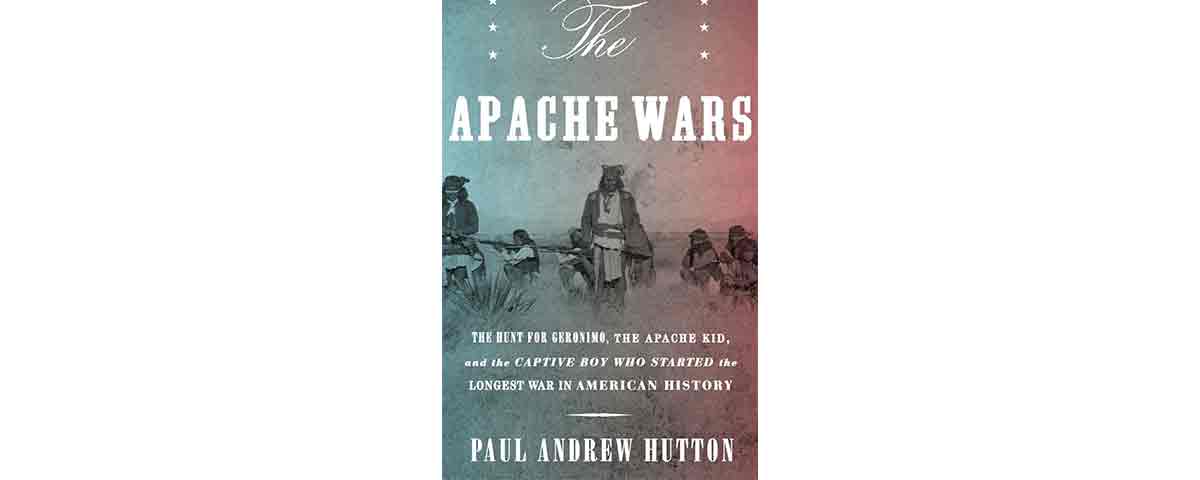The Apache Wars: The Hunt for Geronimo, the Apache Kid, and the Captive Boy Who Started the Longest War in American History
By Paul Andrew Hutton. 544 pages.
Crown, 2016. $30.
Reviewed by Ron Soodalter
To say that a single volume dedicated to the Apache Wars of the late 19th century is ambitious would be to seriously understate the case. Yet that is precisely what Paul Andrew Hutton, a distinguished professor of history at the University of New Mexico, has undertaken to accomplish. And, to a large extent, he has succeeded.
The author presents an intriguingly revisionist picture of some of the major figures in the conflict. Geronimo, who today is seen as selfless and noble, comes across as ego-driven, petulant, and devious. Hutton, in a recent interview, described him as “always only about Geronimo, never about the people.” Other Apache leaders, such as Mangas Coloradas and Victorio, are shown as more deserving of our admiration. Brigadier General Nelson Miles, whom it has become fashionable to portray as a deceitful narcissist (as in the factually challenged 1993 film Geronimo: An American Legend), is here presented as a competent, responsible officer. Brigadier General George Crook—traditionally shown as empathetic to the plight of the Apache—is depicted as “stunningly arrogant,” callously oblivious to either the needs or the customs of his foe.
Chronologically, the book is seamless, tracing the conflict from its eminently avoidable beginnings to its ultimately tragic conclusion. It is no surprise that the Apaches lost, their warriors killed or shipped off to Florida with their families—for many, an exile tantamount to a death sentence. Since Dee Brown’s Bury My Heart at Wounded Knee painted a depressing but detailed picture of the treatment of the Indians from the time of the first Anglo settlements. In Apache Wars, Hutton takes it a step further, detailing the tragic saga of a people’s desperate, doomed struggle to retain their homeland and some semblance of their way of life.
Although their cause was worthy, the Indians weren’t above resorting to tactics that still engender chills and disgust. Indeed, the U.S. military’s brutal subjugation of a people and their no-holds-barred resolve to resist conquest do not make for genteel reading. To his credit, Hutton manages to keep his descriptions of frontier depredations well-balanced—thorough but not excessively graphic.
The book is not without its issues. While the layman might be perfectly willing to accept Hutton’s quotations and facts without sufficient annotation, the historian is not so sanguine. The author chooses not to cite these individually, instead listing general page references at the end of the book. The result is that many purported statements of fact go unsubstantiated. For example, in detailing the fight in which Captain Emmet Crawford is killed, Hutton describes a bemused Geronimo, along with various other leaders, watching—and laughing—from a nearby promontory. Without crediting any sources, it is impossible to know how Hutton comes to place Geronimo on that hillside or has him uncharacteristically laughing at his enemies’ plight. While it makes for a good story, it begs the question, How do we know?
Some of the sources Hutton does cite raise serious questions. Tom Horn, who served as chief of scouts and witnessed Geronimo’s final surrender, wrote his autobiography while awaiting execution for murder. While Horn may have been a legendary figure of the West, he was also a prodigious liar, more concerned with his legacy than the truth. As most Western historians are aware, much of his personal account is questionable at best. Yet Hutton repeatedly uses it without qualification, and at such crucial points as the capture of Geronimo.
Finally, Hutton has chosen as the central figure of his opus a half-Mexican, halfIrish orphan captive of the Apache. Although Felix Ward, called “Mickey Free,” certainly played a part in the long and bitter struggle, some historians might question whether he warrants a place of such eminence in the book.
Flaws aside, this is a book well worth reading. Hutton is a superb storyteller, and his account of the Apache Wars is skillfully crafted. It is the long-overdue chronicle of a shameful period in our expansionist history, and one that, for a century and a quarter, has been in desperate need of telling. MHQ
Ron Soodalter, a frequent MHQ contributor, has written for the New York Times, Military History, Wild West, and Smithsonian. His most recent book is The Slave Next Door.
[hr]
This article originally appeared in the Autumn 2016 issue (Vol. 29, No. 1) of MHQ: The Quarterly Journal of Military History with the headline: Reviews: Attitudes and Outcomes.
Want to have the lavishly illustrated, premium-quality print edition of MHQ delivered directly to you four times a year? Subscribe now at special savings!






